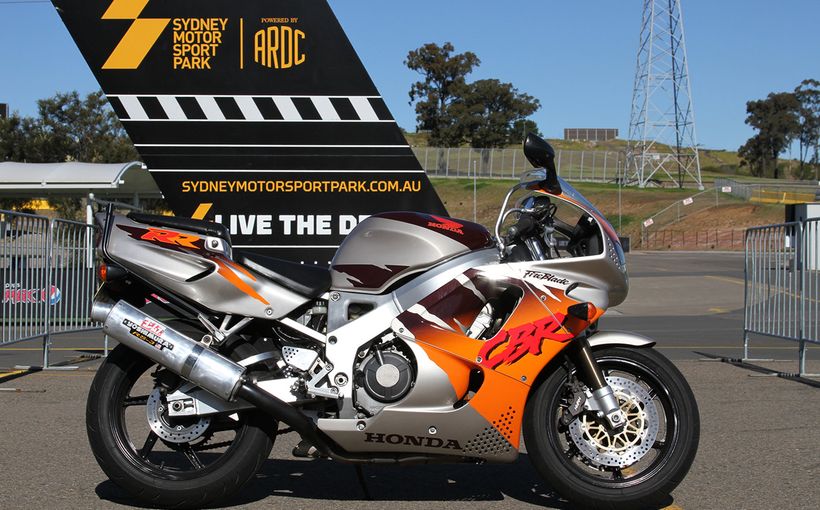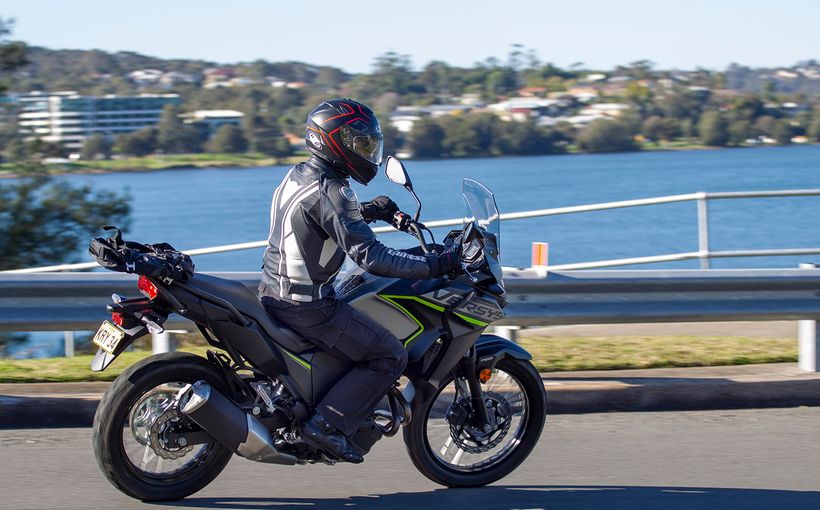Triumph Tiger 800XCx: Burning Bright

You don’t have to try to convince me the Tiger 800 is a fantastic motorcycle. I’ve been a fan since completing the inaugural APC Rally on one, covering 7500km of rough tracks and long roads on a course that included single-track and sand dunes. I dropped it once when a cross-track rut stopped the front end before I could stop the back end, but otherwise the Triumph triumphed in a tough event.
There’ve been at least 48 changes from the original Tiger 800XC to this new XCx. Many of those are little things like colours and finishes, but some are highly significant — the switch to quality WP suspension being right up there. The Tiger at last has electronic riding modes, too. Those two updates are worth the entry price, and others add to the value. Knowing how complicated it was to get to the air filter of the original Tiger, Triumph Australia’s tech man, Cliff Stovall, made a pre-filter system for the APC Rally bikes; that Aussie innovation is now a standard feature of the model, meaning riders can now quite easily clean the dust from the intake system while touring the outback.

Customer feedback has featured highly in the changes, which include 14.5mm higher handlebars, less chain clatter, grippier and more robust seat material, cruise control for the x-spec models and much more. Underneath it all, though, the basic and brilliant Tiger 800 is still the same solid, satisfying and fun all- rounder it was. If you’ve ridden one before, you’ll feel immediately familiar with it as you take off. The new ride-by-wire throttle feels a little lighter and the WP suspension is firmer and more sensitive to little bumps, but it’s that same lovely three-cylinder whir, the same comfort, the same easy control as you get going.
The improved fuel injection, revised camshafts and re-ported cylinder head help it meet the fourth generation of European emissions laws and haven’t done any harm to the quality of the output. The torque and power curves are about as flat and smooth as ironed silk. If you want flexible power delivery, how does it sound to have top-gear pulling power from below 2000rpm all the way to redline in one consistent surge? I rode a mountain fire trail, including its rocky uphill hairpins, in top gear for more than half an hour, only resorting to clutch-slipping twice when I had to trickle around fallen trees. It’s really that good.
It’s almost ironic that this fat powerband is backed by one of the sweetest gearboxes in all of motorcycling. The shift action is short, precise, light and quiet, and the clutch is often optional.
Yes, compared with the 1200cc big guns of adventure-touring, the Tiger’s sub-100hp output sounds unexciting and its 79Nm torque isn’t as macho but I guarantee there’s plenty of grunt for even two-up riding. On a hard- revving fang up the Oxley Highway I didn’t feel the need for more, particularly when I activated the Sport throttle mapping which gives instant response to your right wrist. The Road map (see “In the Mode” below for the details about the electronics) was more comfortable for tooling along, and like the other maps it only varies the speed of the butterflies as they open; power isn’t held back.
Going to Rain mapping, the response is intentionally slow, the throttle feeling dull. You’re less likely to lose traction this way, but I can’t imagine using it much because of the traction control backing you up. Better safe than sorry, perhaps? It might be good in muddy off-roading when you’re forced to deactivate TC just to get drive. The Off Road throttle map comes on a little more gently than the Road setting and it’s fine in that role, but I really enjoyed using Sport mode at times on dirt roads for its more precise control and quick reaction. Horses for courses, I guess, and the key point is the choice you get; setting the throttle is another tuning aid you can use to fit the bike to your riding style.
I spent most of my first day on the 800XCx in Off Road mode whenever we were on dirt, which was most of the time. The TC was good, permitting enough power sliding to finish off turns or flick the back out briefly, and I almost didn’t bother trying anything else. But with the traction aid off, I discovered that your right wrist is usually the only aid you need because the power delivery and feedback from the chassis are very good. It’s only the greasiest or gravelliest roads that tempt you to revert to electronic control. Without it, the Tiger is capable of lovely, long drifts out of sweeping bends and neat little sideways flicks out of low-speed corners. The feedback provided by the WP rear suspension is much clearer than it was on the old model, helping greatly.

Up front, the combo of WP fork, good brakes, well-calibrated ABS and the Karoo’s knobs was dynamite. The Tiger screams into dirt-road corners, perfectly happy for you to push it hard. Again, feedback and precision are fantastic. The Off Road ABS setting encourages you to lock up the rear brakes and slide in (it’s not hard; feedback from the rear brake isn’t great) while you point the front wherever it needs to be. On tar roads the skinny front tyre — especially the Karoo — feels less comfortable and won’t pull you up like a 19- or 17-inch tyre would, but them’s the breaks. It’s still good enough, and a compromise you happily make in return for the adventure- riding brilliance. The forks have rebound and compression damping adjustments in individual legs with adjusters on top. You can tweak them on the go with your fingers. I upped the compression for a while by two clicks but it was too firm for my taste and I went back to standard settings, which seemed ideal for my 75kg.
Road or not, the Tiger’s chassis balance and steering precision cooperate on an almost intuitive level. For a bike weighing 221kg fuelled up, it’s astonishingly willing to hit the exact piece of road you aim it at. On sealed surfaces it responds best to taking graceful rather than aggressive lines but on unsealed roads you can virtually do what you like. It’ll plug along on wide arcs if you’re cruising or act like a wannabe enduro bike when you’re in the mood to play. The suspension backs you up here, too, absorbing big hits without much bottoming out - miles less than with the original suspension. And it keeps its cool for much longer.

For long days in the saddle, the seat is quite comfortable and the screen, though not adjustable, is effective with a minimum of messy air disturbing your helmet. Heated grips are an accessory only but the hand guards deflect a lot of the air’s chill. Leg room is adequate, and the pillion accommodation is good — in fact, in this mid-weight adventure-tourer class it’s probably the pick of them for two-up use, with great grab handles.
The plastic radiator guard and aluminium bash plate increase the overall robustness of the Tiger, whose bodywork has been redesigned so it’s a little less vulnerable too. The steel-tube frame is repairable to a point, more so than an alloy frame, but it still lacks a bolt-on subframe or even bolt-on pillion-peg hangers. This means a bit too much damage at the back can dictate fitting a whole new frame. The wire-spoked wheels are tougher than alloys.

Triumph claims a 17 per cent improvement in fuel economy from this new model, most of it being down to the ride-by-wire throttle which damps your uneconomical wrist actions. It certainly can be a frugal bike, using 4.5L/100km at a steady 90-100km/h, but if you raise it to 120 the consumption goes up to around 6.0L/100km. If I was excited enough I could make it swallow well over 6.5L/100km on trail sections, and my overall average on what was often a pretty hard-riding test was 5.8L/100km. That still gives a range of just over 300km, which isn’t bad.
One area where the Triumph falls behind is in changing riding modes on the move. In general, you can’t unless you’re going from Road to Off Road, because if the ABS or TC need re-activating you must stop to let the wheels ‘sync’. Even then I found the dash- mount button was in an awkward place and frequently didn’t respond. Triumph needs to get this system working smoothly on the fly via a handlebar-mounted control. While they’re at it, it’d be nice to have two or three programmable Rider modes so you can have several pre-set and ready to go at any time.

I wouldn’t let this stop me buying the XCx. In this class of adventure-touring bike with a mid-sized motor and 21-inch front wheel, there’s three other bikes to consider, and one of them’s the 800XC. I’d pay the extra grand for the XCx’s extras, no doubts at all. The other two are BMW’s F800GS and F800GS Adventure, which are separated by $2000 with the XCx almost bang in between. You do the maths, factoring in what you think of the electronics packages (and their added cost in BMW’s case), tank sizes and so on. It’s a competitive fight, for sure. The things that unarguably weigh in Triumph’s favour are its smoother engine with broader power delivery, its overall comfort and the genius of its WP suspension. That last one is what would get me — it lifts the Tiger’s handling onto another level.

IN THE MODE
A TIGER’S RANGE











